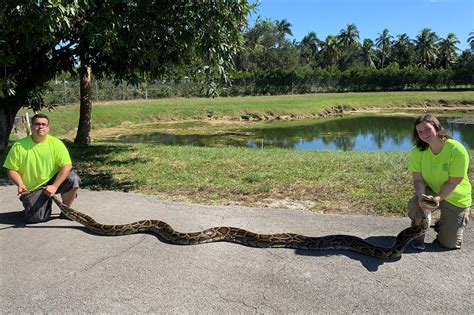
A trio of Florida hunters captured a massive Burmese python stretching nearly 19 feet and weighing 125 pounds in the Florida Everglades, potentially setting a new record for the longest python caught through the state’s Python Elimination Program.
Three men hunting in the Florida Everglades have captured a behemoth Burmese python, potentially setting a new record for the state’s Python Elimination Program. The massive snake, measuring nearly 19 feet long and weighing 125 pounds, was caught on Friday night in the Everglades, according to a Facebook post by one of the hunters, Jake Waleri.
Waleri, along with Stephen Gauta and Joshua Laquis, were hunting in the Everglades when they encountered the monstrous reptile. The capture highlights the ongoing efforts to control the invasive species that has wreaked havoc on the Everglades ecosystem. The Florida Fish and Wildlife Conservation Commission (FWC) and the South Florida Water Management District (SFWMD) run the Python Elimination Program, which incentivizes hunters to remove these snakes from the wild.
“It is awesome to be able to remove these snakes from our ecosystem,” Waleri told Fox News. “They are very detrimental to the wildlife here, and every one we remove is a step in the right direction.”
The massive python was taken to the Conservancy of Southwest Florida for official measurements and data collection. There, biologists confirmed the snake’s impressive size, documenting its length and weight. While the current record for the longest python captured through the Python Elimination Program is just over 18 feet, this new catch could surpass that record pending official confirmation.
“It was a beast,” Waleri stated, describing the moment they realized the size of the snake. The hunters used a bag to subdue the python before bringing it in for official measurement.
The Burmese python is an invasive species in Florida, primarily affecting the Everglades. These snakes, originally native to Southeast Asia, have thrived in the state’s warm, humid climate, where they have few natural predators. The introduction of Burmese pythons into the Everglades is largely attributed to accidental or intentional releases of pet snakes.
Since their establishment in Florida, Burmese pythons have significantly impacted native wildlife populations. They are known to prey on a wide range of animals, including birds, mammals, and reptiles, disrupting the delicate balance of the Everglades ecosystem. The decline in populations of some native species has been linked to python predation.
The Python Elimination Program is one of several initiatives aimed at controlling the python population in Florida. The program pays hunters a bounty for each python they capture, incentivizing them to actively search for and remove these snakes from the Everglades. Participants in the program undergo training to learn how to safely and effectively capture pythons.
In addition to the Python Elimination Program, other control methods are being explored and implemented. These include research into python behavior and ecology, the use of detection dogs to locate pythons, and the development of new technologies for python removal. The goal is to develop a comprehensive strategy for managing the python population and mitigating its impact on the Everglades ecosystem.
The recent capture of the nearly 19-foot python serves as a reminder of the ongoing challenges posed by invasive species in Florida and the importance of continued efforts to control their populations.
Detailed Context and Background:
The Everglades, a unique and vital ecosystem in South Florida, has faced numerous environmental challenges, including the introduction of invasive species. Among the most concerning of these is the Burmese python (Python bivittatus), a large constrictor snake native to Southeast Asia. The presence of Burmese pythons in the Everglades has had a profound impact on the native wildlife populations and the overall health of the ecosystem.
Origin and Introduction:
The Burmese python was first documented in Everglades National Park in the 1990s. The most commonly accepted explanation for their introduction is the accidental or intentional release of pet pythons into the wild. Florida’s warm and humid climate, similar to that of Southeast Asia, provided an ideal environment for these snakes to thrive. The lack of natural predators and the abundance of prey further contributed to their establishment and rapid population growth.
Ecological Impact:
Burmese pythons are apex predators, meaning they are at the top of the food chain. They prey on a wide variety of animals, including birds, mammals, and reptiles. Studies have shown significant declines in populations of some native species in areas where pythons are prevalent. For example, populations of raccoons, opossums, bobcats, and rabbits have decreased dramatically in certain parts of the Everglades.
The pythons’ indiscriminate feeding habits pose a threat to many endangered and threatened species in the Everglades. They have been known to consume wading birds, such as the endangered wood stork, and small mammals, such as the endangered Key Largo woodrat. The loss of these species can have cascading effects on the ecosystem, disrupting food webs and altering ecological processes.
Control and Management Efforts:
Recognizing the severity of the threat posed by Burmese pythons, state and federal agencies have implemented various control and management efforts. These efforts aim to reduce the python population and mitigate their impact on the Everglades ecosystem.
Python Elimination Program:
The Python Elimination Program, run by the Florida Fish and Wildlife Conservation Commission (FWC) and the South Florida Water Management District (SFWMD), is a key component of the state’s python control strategy. The program pays hunters a bounty for each python they capture, incentivizing them to actively search for and remove these snakes from the wild. Participants in the program undergo training to learn how to safely and effectively capture pythons.
Research and Monitoring:
Research plays a crucial role in understanding python behavior, ecology, and impacts on the Everglades ecosystem. Scientists are studying python movements, diet, reproduction, and habitat use to inform management decisions. Monitoring efforts track python population trends and assess the effectiveness of control measures.
Detection Dogs:
Detection dogs are being used to locate pythons in the Everglades. These dogs are trained to detect the scent of pythons and can cover large areas of terrain more efficiently than humans. Detection dogs have proven to be a valuable tool in python removal efforts.
New Technologies:
Researchers are exploring new technologies for python control, such as traps, attractants, and genetic control methods. The goal is to develop innovative and effective tools for managing the python population in the Everglades.
Challenges and Future Directions:
Despite the ongoing control efforts, managing the Burmese python population in the Everglades remains a significant challenge. The pythons’ cryptic behavior, ability to reproduce rapidly, and adaptability to different habitats make them difficult to eradicate.
Future research and management efforts will need to focus on developing more effective control methods, improving monitoring techniques, and preventing the introduction of new invasive species. Public awareness and education are also essential to prevent the release of pet pythons into the wild.
The recent capture of the massive python serves as a reminder of the ongoing challenges posed by invasive species in Florida and the importance of continued efforts to protect the Everglades ecosystem.
Legal and Ethical Considerations:
The management of invasive species like the Burmese python raises several legal and ethical considerations. The implementation of control measures, such as the Python Elimination Program, must comply with state and federal laws and regulations. Ethical concerns arise regarding the humane treatment of captured pythons and the potential impacts of control methods on non-target species.
Invasive Species Management Policies:
Florida has a comprehensive framework of laws and policies aimed at managing invasive species. The Florida Fish and Wildlife Conservation Commission (FWC) has the authority to regulate the possession, sale, and transportation of invasive species. The state also has programs in place to prevent the introduction and spread of new invasive species.
Ethical Considerations:
The humane treatment of captured pythons is a concern for many people. The FWC provides guidance on proper handling and euthanasia techniques for pythons. Efforts are also being made to minimize the impact of control methods on non-target species. For example, researchers are developing python-specific traps that are less likely to capture other animals.
Public Awareness and Education:
Public awareness and education are crucial for preventing the introduction and spread of invasive species. The FWC and other organizations conduct outreach programs to educate the public about the impacts of invasive species and the importance of responsible pet ownership.
The Role of Citizen Science:
Citizen science initiatives engage volunteers in data collection and monitoring efforts. Citizen scientists can help track python sightings, report invasive species, and participate in habitat restoration projects. These initiatives can increase public awareness and engagement in invasive species management.
Economic Impact:
The presence of Burmese pythons and other invasive species can have significant economic impacts. The costs associated with controlling invasive species, repairing damage to infrastructure, and managing natural resources can be substantial. Invasive species can also negatively impact agriculture, tourism, and other industries.
Economic Costs of Invasive Species:
The economic costs of invasive species in the United States are estimated to be billions of dollars per year. These costs include direct expenses for control and management efforts, as well as indirect costs associated with damage to natural resources and economic losses.
Impact on Agriculture:
Invasive species can damage crops, reduce yields, and increase the costs of agricultural production. Invasive insects, weeds, and diseases can all have significant impacts on agriculture.
Impact on Tourism:
Invasive species can negatively impact tourism by damaging natural resources, reducing recreational opportunities, and posing threats to human health. For example, invasive algae blooms can close beaches and harm marine life.
Future Research Directions:
Future research on Burmese pythons and other invasive species should focus on developing more effective control methods, improving monitoring techniques, and understanding the complex interactions between invasive species and native ecosystems.
Genomic Research:
Genomic research can provide insights into the genetic makeup, evolutionary history, and adaptive potential of invasive species. This information can be used to develop targeted control strategies and predict the spread of invasive species.
Ecological Modeling:
Ecological modeling can be used to simulate the spread of invasive species and assess the effectiveness of control measures. These models can help inform management decisions and prioritize control efforts.
Community Involvement:
Community involvement is essential for successful invasive species management. Engaging local communities in monitoring, control, and restoration efforts can increase public awareness and support for invasive species management.
Conclusion:
The capture of the gigantic Burmese python in the Florida Everglades underscores the persistent threat posed by invasive species to delicate ecosystems. The state’s ongoing efforts to manage and control these populations are vital for protecting native wildlife and preserving the ecological integrity of this unique environment. While programs such as the Python Elimination Program and ongoing research initiatives represent significant steps forward, continued vigilance and innovative strategies are crucial to effectively address this ecological challenge and maintain the biodiversity of the Florida Everglades. The partnership between scientists, conservationists, hunters, and the public remains essential in mitigating the adverse impacts of invasive species and ensuring the long-term health and resilience of the region’s natural environment.
Frequently Asked Questions (FAQs):
-
What is the Python Elimination Program?
The Python Elimination Program is a state-run initiative by the Florida Fish and Wildlife Conservation Commission (FWC) and the South Florida Water Management District (SFWMD) that pays hunters a bounty for each Burmese python they capture in designated areas, primarily the Everglades. The program aims to reduce the population of this invasive species and mitigate its impact on native wildlife. As Waleri mentioned, “It is awesome to be able to remove these snakes from our ecosystem. They are very detrimental to the wildlife here, and every one we remove is a step in the right direction.”
-
Why are Burmese pythons considered a problem in Florida?
Burmese pythons are an invasive species in Florida, meaning they are not native to the area and cause harm to the environment, economy, or human health. They are apex predators with no natural predators in the Everglades, allowing them to prey on a wide range of native species, leading to significant declines in populations of animals like raccoons, opossums, and bobcats. This disruption to the ecosystem’s balance is a major concern for conservationists.
-
How did Burmese pythons get to Florida?
The most widely accepted theory is that Burmese pythons were introduced to Florida through the accidental or intentional release of pet snakes into the wild. Florida’s warm and humid climate closely resembles the python’s native habitat in Southeast Asia, allowing them to thrive and reproduce in the Everglades.
-
What is being done to control the Burmese python population in Florida besides the Python Elimination Program?
In addition to the Python Elimination Program, other control methods include research into python behavior and ecology, the use of detection dogs to locate pythons, and the development of new technologies for python removal. Agencies are also working to educate the public about the dangers of releasing exotic pets into the wild.
-
What happens to the pythons that are captured through the Python Elimination Program?
Captured pythons are typically taken to research facilities like the Conservancy of Southwest Florida where they are measured, weighed, and studied. Data is collected on their size, diet, and reproductive habits to better understand the species and inform management strategies. In most cases, the pythons are humanely euthanized, as their presence poses a threat to the native ecosystem. The bodies are then used for further research or educational purposes.
-
What is the typical size of a Burmese Python in Florida?
While Burmese pythons in their native Southeast Asia can reach lengths of up to 23 feet, in Florida, the typical size varies. However, mature pythons regularly reach lengths of 8 to 12 feet. Individuals exceeding 15 feet are less common but documented, and those approaching 19 feet, as in the case of Waleri’s catch, are exceptional. Factors such as food availability, habitat quality, and age influence the size a python can attain.
- Are Burmese Pythons Dangerous to Humans?
Burmese pythons are powerful constrictors capable of inflicting serious injuries. However, attacks on humans are rare. Most pythons, especially smaller ones, are more likely to avoid confrontation. Larger pythons pose a greater potential threat, particularly to small children. It is advisable to exercise caution and maintain a safe distance if encountering a python in the wild.
- What is the Ecological Significance of the Everglades?
The Everglades is a unique and vital ecosystem, often referred to as the “River of Grass.” It is a subtropical wetland that supports a rich diversity of plant and animal life, including numerous endangered and threatened species. The Everglades also plays a crucial role in water storage, flood control, and water filtration for South Florida’s growing population. The introduction of invasive species like the Burmese python threatens the delicate balance of this ecosystem, impacting its biodiversity and ecological functions.
- How Can the Public Help in Python Control Efforts?
Members of the public can contribute to python control efforts in several ways. Reporting python sightings to the Florida Fish and Wildlife Conservation Commission (FWC) helps track the spread of the species. Avoiding the release of exotic pets into the wild prevents further introductions of invasive species. Supporting conservation organizations and initiatives that focus on python control and Everglades restoration can also make a difference. Additionally, participating in citizen science projects, such as monitoring python populations or assisting with habitat restoration, can provide valuable data and hands-on assistance.
- What are the Long-Term Prospects for Python Control in the Everglades?
The long-term prospects for python control in the Everglades remain uncertain. While current control efforts have shown some success in reducing python populations in localized areas, the overall population continues to be a challenge. Continued research, development of new control technologies, and sustained funding for control programs are essential for achieving meaningful progress. Preventing the introduction of new invasive species is also crucial for protecting the Everglades ecosystem from future threats. Eradication is unlikely, but effective management to minimize ecological damage is the primary objective.
- What kind of training do the Python Elimination Program participants receive?
Participants in the Python Elimination Program undergo comprehensive training to ensure they can safely and effectively capture Burmese pythons. The training covers several key areas, including python identification, safe handling techniques, capture methods, and ethical considerations. Participants learn how to distinguish Burmese pythons from native snakes, how to approach and capture pythons without causing harm to themselves or the snake, and how to humanely euthanize the pythons. The training also emphasizes the importance of adhering to all applicable laws and regulations and minimizing the impact on non-target species and the environment.
- Are there any specific areas within the Everglades where pythons are more prevalent?
Yes, certain areas within the Everglades are known to have higher densities of Burmese pythons due to factors such as habitat suitability, prey availability, and historical introduction points. Areas with dense vegetation, abundant water sources, and proximity to urban areas tend to be more favorable for pythons. Specific regions, such as Everglades National Park, Big Cypress National Preserve, and the Francis S. Taylor Wildlife Management Area, have been identified as hotspots for python activity. Targeted control efforts are often focused on these areas to maximize the effectiveness of python removal efforts.
- What is the typical diet of a Burmese Python in the Everglades?
Burmese pythons in the Everglades have a broad diet that includes a variety of native wildlife species. They are opportunistic predators and will consume whatever prey is available. Common prey items include mammals such as raccoons, opossums, rabbits, deer, and bobcats. They also prey on birds, reptiles (including alligators), and amphibians. The impact of python predation on native wildlife populations has been a major concern, leading to significant declines in some species.
- How does the removal of Burmese Pythons affect the Native Wildlife Populations in the Everglades?
The removal of Burmese pythons from the Everglades has a positive impact on native wildlife populations by reducing predation pressure. Studies have shown that areas where python control efforts are focused experience a rebound in populations of some native species, such as raccoons and opossums. However, the recovery of native wildlife populations is a complex process that depends on various factors, including habitat quality, food availability, and the presence of other stressors. Sustained python control efforts are needed to ensure the long-term recovery of native wildlife in the Everglades.
- Are there any native snakes in Florida that are often mistaken for Burmese Pythons?
Yes, several native snakes in Florida can be mistaken for Burmese pythons, particularly by individuals who are not familiar with snake identification. The most common example is the Florida Water Snake (Nerodia floridana), which has a similar body shape and coloration to juvenile Burmese pythons. However, Florida Water Snakes are non-venomous and pose no threat to humans. Other native snakes that may be confused with pythons include the Eastern Diamondback Rattlesnake (Crotalus adamanteus) and various species of rat snakes (Pantherophis spp.). It is important to learn how to properly identify snakes to avoid misidentification and ensure appropriate responses.
- What role do detection dogs play in locating Burmese Pythons?
Detection dogs are a valuable tool in locating Burmese pythons in the Everglades due to their highly developed sense of smell. These dogs are specifically trained to detect the scent of pythons, even when the snakes are hidden in dense vegetation or underground burrows. The dogs can cover large areas of terrain more quickly and efficiently than humans, increasing the chances of finding and removing pythons. Detection dog teams are often deployed in areas where python densities are known to be high, or in areas where traditional survey methods are less effective.
- What types of research are being conducted to better understand and control Burmese Pythons?
Ongoing research on Burmese pythons is focused on several key areas, including python behavior and ecology, diet and feeding habits, reproductive biology, genetics, and the development of new control technologies. Researchers are using tracking devices to monitor python movements, analyzing python stomach contents to determine their diet, and studying python genetics to understand their evolutionary history and adaptation to the Everglades environment. They are also exploring new control methods, such as traps, attractants, and genetic control technologies, with the goal of developing more effective and targeted strategies for managing the python population.
- How does climate change potentially impact the Burmese Python population in Florida?
Climate change has the potential to exacerbate the problem of Burmese pythons in Florida by expanding their suitable habitat range and increasing their reproductive success. Warmer temperatures may allow pythons to expand their distribution northward, potentially impacting new areas and ecosystems. Changes in rainfall patterns and sea levels could also alter habitat conditions in the Everglades, further favoring python populations. Additionally, climate change-related stressors on native wildlife populations could make them more vulnerable to python predation. Addressing climate change is therefore an important component of long-term python management efforts.
- What are the ethical considerations surrounding the capture and euthanasia of Burmese Pythons?
The capture and euthanasia of Burmese pythons raise several ethical considerations, including the humane treatment of the snakes and the potential impacts on non-target species. Efforts are made to ensure that pythons are captured and handled in a way that minimizes stress and injury. Euthanasia methods are chosen to be as humane and painless as possible. There are debates about the ethics of killing an animal, even if it is an invasive species. The decision to euthanize pythons is based on the recognition that their presence poses a significant threat to native wildlife populations and the overall health of the Everglades ecosystem.
- What is the role of public education in preventing future introductions of invasive species?
Public education plays a crucial role in preventing future introductions of invasive species by raising awareness about the dangers of releasing exotic pets into the wild and promoting responsible pet ownership practices. Many invasive species are introduced through the pet trade, either intentionally or accidentally. Educating the public about the potential consequences of releasing exotic animals and promoting the responsible disposal of unwanted pets can help prevent future introductions. Public education efforts also focus on increasing awareness about the impacts of invasive species on native ecosystems and the importance of supporting control and management efforts.









